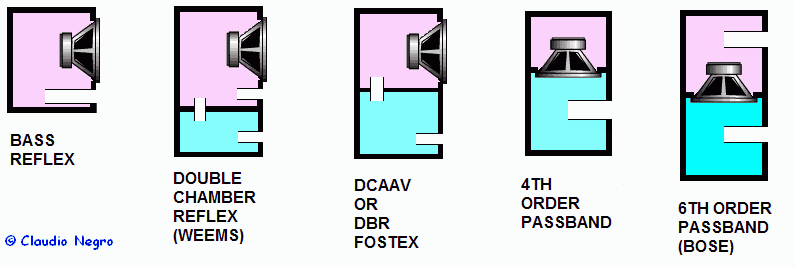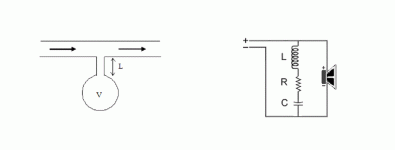In reading on the net about Dunlavy Loudspeakers, I came across a post by someone who, if I recall correctly, worked for Dunlavy at one time.
The poster mentioned that Dunlavy woofer cabinets were ducted or vented enclosures that were inside of larger sealed cabinets.
Does anyone here have an opinion as to if this is even possible?
I'm getting ready to design a large enclosure that will house a smaller vented enclosure. Using either a 12" or 15" driver.
Opinions appreciated.
The poster mentioned that Dunlavy woofer cabinets were ducted or vented enclosures that were inside of larger sealed cabinets.
Does anyone here have an opinion as to if this is even possible?
I'm getting ready to design a large enclosure that will house a smaller vented enclosure. Using either a 12" or 15" driver.
Opinions appreciated.
Something like this?
Loudspeaker enclosure calculating with Thiele Small parameter
Loudspeaker enclosure calculating with Thiele Small parameter
ELIPSON - Resonator
Provide more details of the Dunlavy speaker you know.
Elipson replica
Gamme ELIPSON en 1975
Résonateur ELIPSON
What you are describing looks a lot like a frequency trap (that I doubt!) used a lot by the French, eg. Elipson.In reading on the net about Dunlavy Loudspeakers, I came across a post by someone who, if I recall correctly, worked for Dunlavy at one time.
The poster mentioned that Dunlavy woofer cabinets were ducted or vented enclosures that were inside of larger sealed cabinets.
Does anyone here have an opinion as to if this is even possible?
I'm getting ready to design a large enclosure that will house a smaller vented enclosure. Using either a 12" or 15" driver.
Opinions appreciated.
Provide more details of the Dunlavy speaker you know.
Elipson replica
Gamme ELIPSON en 1975
Résonateur ELIPSON
Attachments
The post I read was rather vague but I believe he was an ex employee at Dunlavy Audio Labs. It was just something simple like " the secret to the extended deep bass was a cabinet that was vented inside of a sealed cabinet".
Nothing more than that and I doubt I could find the post again.
I see from one of your links that a French company used this technique.
My French is poor so I can't translate what the papers say.
Thanks for the info.
Nothing more than that and I doubt I could find the post again.
I see from one of your links that a French company used this technique.
My French is poor so I can't translate what the papers say.
Thanks for the info.
I see by the graphs,the Resonator behaves differently with a sealed chamber vented into another sealed chamber.
Sadly, I don't read French so I cannot tell what the graphs are telling me.
Are they saying that better bass and a lower F 3 are possible with this type of enclosure?
If so, how do I work a woofers specs to determine cabinet size, etc.?
The past quote of the Dunlavy employee who stated the use of this got my interest as the minus F3 points of Dunlavy speakers are always very low.
Much lower than the numbers I get when doing the sealed box math for the woofers he used.
Dunlavy used a pair of Scanspeak 8565 10" woofers in his SCIV A.
And, Vifa M30 12" woofers in the SCV.
Both speakers tested well below the F3 points that I get on paper when doing the math for them.
Thanks for your help.
Sadly, I don't read French so I cannot tell what the graphs are telling me.
Are they saying that better bass and a lower F 3 are possible with this type of enclosure?
If so, how do I work a woofers specs to determine cabinet size, etc.?
The past quote of the Dunlavy employee who stated the use of this got my interest as the minus F3 points of Dunlavy speakers are always very low.
Much lower than the numbers I get when doing the sealed box math for the woofers he used.
Dunlavy used a pair of Scanspeak 8565 10" woofers in his SCIV A.
And, Vifa M30 12" woofers in the SCV.
Both speakers tested well below the F3 points that I get on paper when doing the math for them.
Thanks for your help.
Inductor appears to be right about the frequency trap. Untitled Document They are intended to filter out unwanted resonances.
In reading on the net about Dunlavy Loudspeakers, I came across a post by someone who, if I recall correctly, worked for Dunlavy at one time.
The poster mentioned that Dunlavy woofer cabinets were ducted or vented enclosures that were inside of larger sealed cabinets.
The flagship Duntech Sovereign loudspeaker used a sealed enclosure.
SOVEREIGN
Duntech states - "An optimized, sealed enclosure is used to provide accurate reproduction in preference to a vented enclosure which very often produces a woolly or ill-defined sound."
I am playing around with some sims of a sealed-vent-sealed cabinet and it is very interesting. It is definitely not the same as a sealed or a vented cabinet! There is a large parameter space to play with: volume of chambers, ratio of volumes, vent CSA, vent length. What I am seeing is that you will not get deeper bass than a vented but you will get deeper bass than a sealed but with the nice clean impulse response and lower group delay of a sealed cabinet. The other side benefit is that the excursion is very controlled - order of magnitude better than a plain sealed cabinet so you can drive to insane SPL's without hitting xmax - equivalent to lower distortion at normal music SPL's. So far it seems that there are some benefits and some trade offs - as usual in audio designs. This appears to be a unique alignment - does it have a name?
Last edited:
@ xrk971
Re Post # 11
Sounds good, keep us posted !
Re Post # 11
Sounds good, keep us posted !
Well we havn't seen it yet, but how about QBL = Quasi Box LoadingThis appears to be a unique alignment - does it have a name?
so you can drive to insane SPL's without hitting xmax - equivalent to lower distortion at normal music SPL's.
Hi,
How do you work that out, its simply not true.
Assuming your talking two sealed joined by a vent.
rgds, sreten.
I am playing around with some sims of a sealed-vent-sealed cabinet and it is very interesting. It is definitely not the same as a sealed or a vented cabinet! There is a large parameter space to play with: volume of chambers, ratio of volumes, vent CSA, vent length. What I am seeing is that you will not get deeper bass than a vented but you will get deeper bass than a sealed but with the nice clean impulse response and lower group delay of a sealed cabinet. The other side benefit is that the excursion is very controlled - order of magnitude better than a plain sealed cabinet so you can drive to insane SPL's without hitting xmax - equivalent to lower distortion at normal music SPL's. So far it seems that there are some benefits and some trade offs - as usual in audio designs. This appears to be a unique alignment - does it have a name?
Very interesting!
It appears that the ex Dunlavy employee's statement is true.
What software/program are you using to run your sims?
You pretty much have to do this in AkAbak. Quite simple really with two chambers one vent a driver (or two) and a direct radiator on the driver.
@sreten - it does achieve higher SPL than a plain sealed box of equivalent volume but you will have a loss of bandwidth - more applicable to a full range driver or mid bass driver than a sub. Some alignments like the Karlson achieve better cone motion control than a sealed box. Same with FLH's. This just happens to control the motion on the back side and nothing gets out the back.
@sreten - it does achieve higher SPL than a plain sealed box of equivalent volume but you will have a loss of bandwidth - more applicable to a full range driver or mid bass driver than a sub. Some alignments like the Karlson achieve better cone motion control than a sealed box. Same with FLH's. This just happens to control the motion on the back side and nothing gets out the back.
@sreten - it does achieve higher SPL than a plain sealed box of equivalent volume but you will have a loss of bandwidth - more applicable to a full range driver or mid bass driver than a sub. Some alignments like the Karlson achieve better cone motion control than a sealed box. Same with FLH's. This just happens to control the motion on the back side and nothing gets out the back.
Hi,
Your talking nonsense about insane SPL's and no sense at all
about sensibly sized boxes. I know you like the Karlson, I don't,
but FWIW it does do a bit more upper bass SPL, at the cost of
proper bass extension, and any real bass accuracy.
Two sealed boxes joined by a port in a naff design full stop.
Like a DCR or DBR, its using the wrong driver in the wrong box.
Always you can do better using the right driver in the right box.
rgds, sreten.
Last edited:
You pretty much have to do this in AkAbak. Quite simple really with two chambers one vent a driver (or two) and a direct radiator on the driver.
@sreten - it does achieve higher SPL than a plain sealed box of equivalent volume but you will have a loss of bandwidth - more applicable to a full range driver or mid bass driver than a sub. Some alignments like the Karlson achieve better cone motion control than a sealed box. Same with FLH's. This just happens to control the motion on the back side and nothing gets out the back.
Thanks for your time and your reply.
Interesting, but I think he gets results with his choice of filling.
Dunlop Hypersoft HS1730 is what all Dunlavy & Duntech speakers use.
It is mot available anywhere anymore.
I have taken apart many Dunlavy speakers and they all have this in common;
Behind 10” driver (SCIV), completely packed with said foam, then it’s open air until the other woofer
which is designed the same...
I know this is a really old thread but I just stumbled across it.
☠️☠️☠️☠️ Bring out yer dead....
Dunlop Hypersoft HS1730 is what all Dunlavy & Duntech speakers use.
It is mot available anywhere anymore.
I have taken apart many Dunlavy speakers and they all have this in common;
Behind 10” driver (SCIV), completely packed with said foam, then it’s open air until the other woofer
which is designed the same...
I know this is a really old thread but I just stumbled across it.
☠️☠️☠️☠️ Bring out yer dead....
Last edited:
- Home
- Loudspeakers
- Subwoofers
- Vented/sealed sub design

